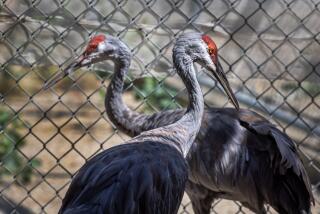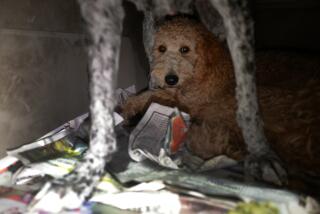Free as a Bird : 6 Condor Chicks Released in Triumphant Moment for Program
- Share via
Six California condor chicks were released into the rugged backcountry of Ventura County in the Los Padres National Forest on Tuesday, joining 18-month-old Xewe as the only seven members of the endangered species now in the wild.
Nine minutes after the door of the birds’ enclosure on 100-foot Arundell Cliff was opened at 9:39 a.m., scientists watched with delight as 8-month-old Koyo, the oldest of the six, spread her giant wings and soared away.
Koyo (pronounced Ko-yoa ), glided in a graceful circle in her 20-second maiden flight deep within the 53,000-acre Sespe Condor Sanctuary before coming in for a bumpy, two-hop landing nearby.
“The flight was like a Michael Jordan dunk--it was so elegant it looked easy,” said an ebullient Lloyd F. Kiff, leader of the U. S. Fish and Wildlife Condor Recovery Team. “For a first-timer, she did fine on the landing as well.”
Kiff and other wildlife officials said the release of the six, which represent about 10% of the total population now alive in zoos as well as in the wild, marked a moment of triumph in the controversial 12-year effort to bring the birds back from near-extinction.
“I think we’re going to save these birds after all,” Kiff said later Tuesday at a news conference in Fillmore.
“We are happy to get the condors back in the wild and back in their homes in the Los Padres National Forest,” said Maeton Freel, wildlife biologist with the U. S. Forest Service.
While Koyo soared, the other five spread their wings--spanning nine feet--and hopped around in front of the cave-like structure, which included a fenced and netted porch. They have been held there since they were airlifted to the site from the Los Angeles Zoo on Oct. 19.
Soon afterward, three more birds took flight, but only one ventured off the cliff.
The six new chicks, four females and two males ranging in age from six to eight months, were confined inside the structure Monday night while biologists dismantled the netting.
Then, Tuesday morning, a biologist in a hidden compartment pulled open the cave door, allowing the birds to hop to freedom on the edge of the white cliff.
“They are a feisty crew and ready to go,” said Robert Mesta, coordinator for the recovery team, a group of experts assembled from throughout the country.
Xewe (pronounced Ga-wee ), who was released last January, will probably become the chicks’ guide to the best places to fly and roost, officials said. She didn’t come to greet the birds when they were first released, but arrived later in the day. She has been spending her days close by, poking her long neck through the fence to preen and be preened by the other birds, Mesta said.
“They have already started to bond, even through a fence,” he said. “And that’s a good sign.” Scientists hope that the birds will breed when they come of age at 4 to 5 years.
Scientists and veterinarians examined, weighed and tagged the six last week and then installed radio transmitters on the birds’ large black wings to track their flight and eating patterns.
The birds will feed on carcasses of stillborn dairy calves that biologists provide to ensure a good, clean food source.
Mesta said that having seven birds in the wild out of the 63 that now exist is a good sign for success of recovery and captive breeding programs at the Los Angeles and San Diego zoos.
Mesta said scientists did not expect to release so many birds for another year.
“The fact that we’ve come this far so soon is testimony to how well the program has worked,” he said.
However, a condor released in January with Xewe died Oct. 8 from kidney failure after he ate antifreeze, presumably drained from a car alongside a road or creek.
Freel said the Forest Service plans to post signs in English and Spanish as well as in Asian languages in backcountry and recreation areas, warning visitors of the presence of the endangered condors and advising them on proper behavior.
The recovery team plans to transfer more birds to the wild every year, probably moving them from the zoos in early fall and releasing them in late fall or early winter.
Next year’s release will be in Santa Barbara County at the eastern edge of the San Rafael Wilderness, which is even more remote than the rugged Sespe Condor Sanctuary, Kiff said. The site is near the Sisquoc Condor Sanctuary, established in 1937, that Kiff said marked the beginning of the effort to save the California condor from extinction.
The plan is to continue releasing birds bred in captivity until they are no longer considered endangered.
Scientists hope to establish at least three separate populations: one in the Los Padres forest, one at the zoos and a third outside California--probably in the Grand Canyon, where the birds soared in abundance until about 10,000 years ago.
When each population has about 150 birds with at least 10 breeding pairs, the program will have reached its goal--a process that could take two decades, Kiff said.
“We’ve been at this too long to commit ourselves to specific dates,” he said. “But we will know for sure if we can save the condor by the year 2000.”
The carrion-eating California condor, which once numbered in the thousands and roamed from Canada to Baja California, was on the brink of extinction in 1982 and 1983, hitting an all-time low of 22 birds, including two or three birds in captivity.
Between 1984 and 1985, six more condors disappeared from the wild, probably shot by hunters.
Many of those that weren’t killed by hunters fell victim to lead poisoning contracted by eating the carcasses of animals that had been shot and left for dead.
To prevent the remaining few condors from perishing in the wild and to establish a captive breeding program with the largest possible genetic pool, scientists decided in late 1985 to catch the last of the wild vultures.
On Easter Sunday, 1987, the Condor Recovery Team captured the last of the wild condors, AC-9, the father of Xewe. The capture marked the first time in as many as 2 million years that no California condors flew in North American skies.
Kiff, who plans to retire from the recovery team next week after 15 years with the program, said it is gratifying to see the birds back in the wild.
“I feel consummated and vindicated,” he said.
Condor Names The six California condors, all assigned Chumash Indian names, are:
Haku, pronounced Ha-coo, meaning hello, a female
Pitahsi, prounounced Pi-tah-she, meaning understanding, a female
Hutash, pronounced, Who-tosh, meaning Earth, a female
Koyo, pronounced Ko-yoa, meaning beginning, a female
Sqap, pronounced Ssh-kap, meaning feather bundle, a male
Niko, pronounced Knee-co, meaning water, a male
More to Read
Sign up for Essential California
The most important California stories and recommendations in your inbox every morning.
You may occasionally receive promotional content from the Los Angeles Times.










